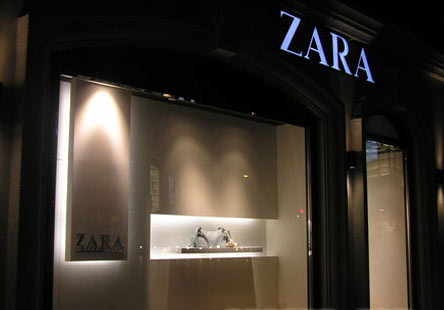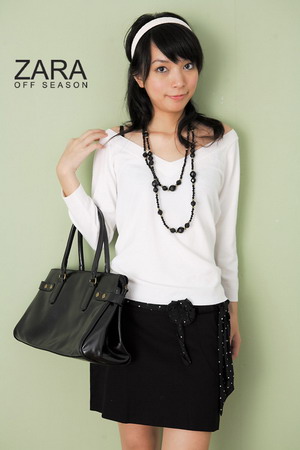In 50 countries, 650 stores and Spanish clothing retailer Zara broke the traditional wisdom and successfully established its own supply chain. How does Zara's supply chain collaborate and complete the design and manufacture of a garment in two weeks?

ZARA settled in Shanghai Times Square on August 11 this year
In Zara's shop, customers can always find new clothes, but their supply is always low. Even if the shop is very spacious (average area is about 1,000 square meters), Zara only puts out a few pieces. The purpose of this is to show personality. Consumers will think: "This green top is very good, there is only one left on the shelf. If I do not start, there is no chance."
Supporting this retail concept is the regular launch of new products and the timely addition of a small number of mechanisms. Zara's designers have to design about 40,000 new products each year, and select 10,000 of them for production. Some of them will imitate the latest fashion trends. But Zara can usually beat those high-end fashion brands in the market, because Zara can use cheap materials to provide the same style of clothing at much lower prices. Since most clothing has five or six colors and six or seven models, Zara handles an average of about 300,000 new stock-keeping units each year.
Design and production blend
This "fast fashion" system relies on the constant exchange of information between every link in the Zara supply chain - from the customer to the store manager, from the store manager to the market specialist and designer, from the designer Go to the production department, from the buyer to the agent, from the warehouse manager to the distribution staff, and so on. Most companies will set up some administrative agencies to manage these affairs, but these administrative agencies will hinder the exchange of information between departments. Zara's situation is different. Its organizational form, operating procedures, performance evaluation, and even institutional settings are designed to facilitate the transmission of information.
Zara's only, centralized design and production center is located at Inditex, the parent company of La Coruna. It consists of three spacious halls: one for women, one for men, and one for children's clothing. Most other companies usually need to cut redundant labor to save costs. Zara does not like this. Its three production departments start at the same time, but their functions are different.

ZARA new autumn
Each of the three departments has its own design, sales, procurement, and production planning staff. A store may receive calls from La Coruna through three different channels in a week; a garment factory may also deal with two Zara managers—one for men's shirts and one for children's shirts. Although the cost of maintaining the three channels is high, the circulation of information within the channels is rapid, direct, and unobstructed by other channels—which can speed up the response of the entire supply chain.
In each hall, people can see the Spanish rural landscape outside the window through the curtain wall glass around the hall, which helps create a sense of randomness and openness. Unlike companies that separate designers, Zara's 200 designers are involved in the production process. On three production lines, these designers, who are over 20 years old, are employed because of their talent and passion for their careers. The pretentious people are unwelcome here - with market specialists, suppliers and Production planners work side by side. Huge circular tables are used to hold the discussion meetings, and the bookshelf with the latest fashion magazines and catalogues is full of walls. Each hall has a corner as a clothing starter store, and everyone is encouraged to comment on the new clothes they are involved in producing.
Data flow is constantly updated
Zara is very cautious in deploying the latest information technology tools to promote information exchange. A handheld computer tailored for Zara is used to provide links between retail stores and La Coruna. These PDAs fill the gaps between regular store calls (usually in surrounding units) between store managers and market specialists. Through PDAs and telephones, the store transmits all the information back to La Coruna - hard information and customer responses including orders and sales trends, as well as various gossips about the new style.
After determining a prototype for production, the designer immediately modified the colors and materials on a computer-aided design (CID) system. If it needs to be produced by Zara's factory, they will transmit the specification data directly to the factory's relevant tailoring machines and other equipment. The well-cut raw materials are made into garments by various steps in production (including sewing usually by subcontractors), shipped, transported to stores, can be tracked by bar code records, and finally the above-mentioned information transmission starts from the retail store. .

ZARA spring and summer new products
This constantly updated stream of data mitigates the so-called "whiplash effect" - this effect is that the supply chain (including all open loop information systems) has a tendency to amplify small deviations. For example, small changes in retail orders, after being transferred to the factory through wholesalers and agents, can result in a drastic change of factory orders. According to the tradition of the clothing industry, retailers can only change orders up to 20% after the sales season starts, but for Zara, the figure is 40% to 50%. In this way, Zara will be able to avoid ubiquitous overproduction, sales declines and high discounts in the industry.
New small batch supply
Surprisingly, the constant supply of small quantities of new products can reduce the cost of specific products. In fact, Zara is happy to have a shortage of raw materials. Customers will not go to other stores because the shelves are empty because Zara can always provide new products for selection. The out-of-stock of a product will stimulate the sale of another product, because people always want to buy what they like.
As an informal policy, Zara will discount the sales of two or three weeks of product distribution. For ordinary shops, this is costly, but Zara's stores are only small shipments, inventory is very small, the risk is naturally low, unsold goods usually only account for 10% of inventory, and the industry's average number is 17 % to 20%.
In addition, the small-volume supply and foreshadowed tight supply practices have stimulated the frequency of customer visits to Zara stores. For example, consumers in the City of London visit only 4 times a year on average, but for Zara's consumers, this number is 17 times. Frequent visits can also reduce the cost of advertising. Zara's advertising investment accounted for only 0.3% of revenue, far less than the 3% to 4% of competitors.
This close proximity of space and organization enhances the speed and quality of apparel design. Designers can quickly and casually check initial sketches with colleagues; market specialists who are in constant contact with store managers (many of whom are themselves store managers) can quickly give an appearance on new clothing (style, color, texture, etc.) ) feedback, as well as market pricing advice; supply personnel and production plan staff can make rough and important estimates of production costs and production quantities; if needed, these collaborative teams can check in the hall within a few hours The resources needed for prototypes, design choices, production arrangements and access to markets.
Cooler bags, Lunch Bag, Insulated Bag
Cangnan Aite Bag Ltd. , http://www.cnpolyesterbag.com